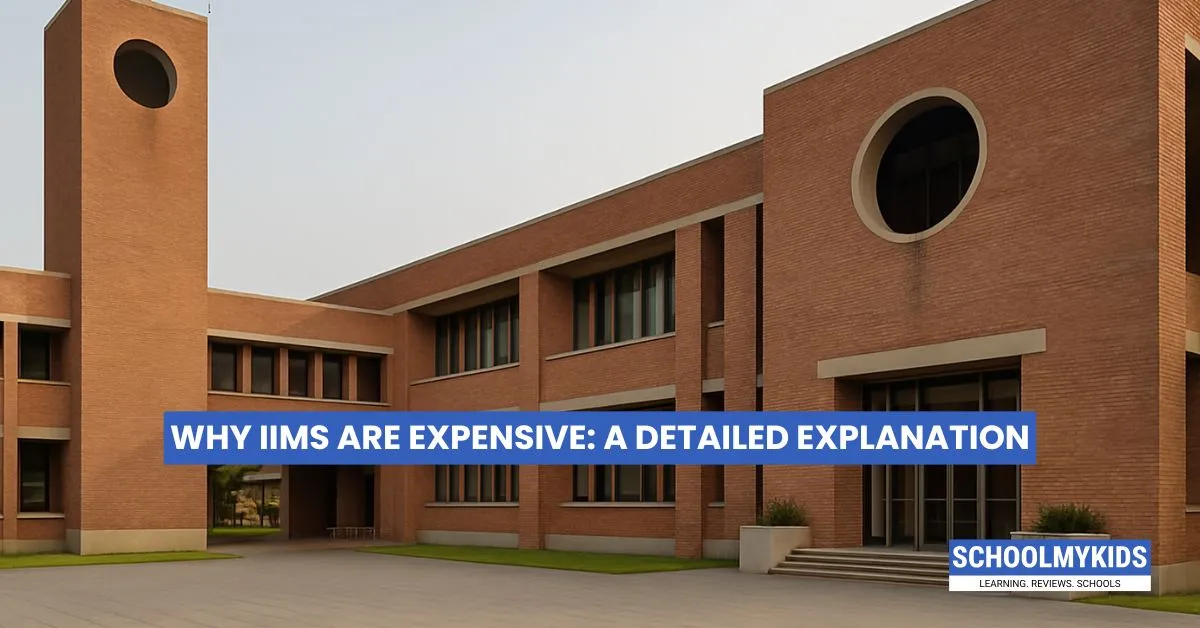The Indian Institutes of Management (IIMs) represent the pinnacle of management education in India. Their flagship two-year MBA programs attract top talent from across the country. However, one frequently asked question is: Why are IIMs so expensive? With fees ranging from ₹15 lakhs to ₹30 lakhs or more, it’s essential to understand what justifies this cost. This article dives deep into the reasons behind the high fees and what sets IIMs apart from traditional government colleges.
1. World-Class Infrastructure
IIMs invest heavily in cutting-edge infrastructure designed to enhance learning and overall student development. This includes:
- Smart classrooms with advanced AV tools
- Digital libraries, Bloomberg terminals, and research labs
- Well-equipped residential hostels and sports complexes
- On-campus incubation and innovation centers
Maintaining such high standards involves significant operational and capital expenses, which are reflected in the tuition fees.
2. Highly Qualified Faculty
IIM faculty members typically hold PhDs from prestigious global universities. They are actively involved in research, consulting, policymaking, and publishing.
- Competitive salaries and research funding are necessary to attract and retain this talent
- Small class sizes ensure personalized mentoring, raising faculty costs per student
- Regular industry engagement and guest lectures add to instructional expenses
3. Autonomous and Self-Financed Model
Since the enactment of the IIM Act, 2017, these institutions have become autonomous and largely self-financed.
- They do not rely heavily on central or state government subsidies
- Most expenses—including salaries, infrastructure, and innovation—are covered through student fees
- Newer IIMs especially have minimal state support, making tuition a primary revenue stream
This financial independence contributes to the higher fee structure.
4. Global Accreditation and International Exposure
IIMs seek and maintain accreditations from global bodies like:
- AACSB (Association to Advance Collegiate Schools of Business)
- AMBA (Association of MBAs)
- EQUIS (European Quality Improvement System)
Achieving and retaining these accreditations requires substantial investment in:
- International collaborations and student/faculty exchange programs
- Global benchmarking and curriculum redesign
- High-quality research output and alumni tracking systems
5. Industry-Focused Curriculum and Pedagogy
Unlike traditional rote learning, IIMs follow a dynamic, case-based learning approach:
- Courses use licensed case studies from institutions like Harvard and INSEAD
- Business simulations, real-time analytics tools, and capstone projects are included
- Constant curriculum updates align with current industry trends
These practices demand more faculty preparation, content licensing, and digital infrastructure—leading to higher costs.
6. Career Services and Placement Infrastructure
IIMs are known for their exceptional placement records, backed by:
- Dedicated corporate relations teams
- Structured resume-building and interview preparation workshops
- Startup incubation, entrepreneur support, and global internships
- Lifetime alumni access to career services in some cases
Sustaining this high-touch career ecosystem is resource-intensive.
7. Student Diversity and Inclusion
To build diverse classrooms, IIMs:
- Run awareness and outreach programs in underrepresented regions
- Offer fee waivers and need-based scholarships to deserving students
- Implement inclusive admissions policies to ensure representation across states, genders, and disciplines
All of this increases administrative costs and support services required on campus.
8. Strong Brand Management and Alumni Engagement
IIMs continuously invest in strengthening their brand:
- Organizing national and international conferences, summits, and competitions
- Maintaining alumni portals, reunions, and donation drives
- Participating in rankings, policy papers, and think tanks
These efforts help maintain the prestige of the IIM brand but require sustained investment.
9. Support Services and Holistic Development
IIMs offer a rich and balanced student life supported by:
- Mental health and career counseling
- Clubs for arts, sports, analytics, public speaking, and more
- Student exchange and leadership bootcamps
These services enhance student experience and skill development, but also add to the operational budget.
10. Capital Investment in Emerging IIMs
Many of the newer IIMs are still developing:
- Permanent campuses with hostels, auditoriums, and labs
- Administrative and tech infrastructure from scratch
- Academic collaborations, research labs, and faculty recruitment pipelines
These early-phase investments result in higher costs per student, especially in the first few batches.
How IIMs Differ from Other Government Colleges
Although IIMs are government institutions, they function very differently from most traditional public colleges in India:
| Feature | IIMs | Traditional Govt Colleges |
| Governance | Autonomous under the IIM Act | Governed by state/central university systems |
| Curriculum | Industry-aligned, globally benchmarked | Often outdated and fixed by central bodies |
| Faculty | Globally trained, active in research | Limited global exposure, often underpaid |
| Infrastructure | Modern, fully equipped campuses | Often underfunded and infrastructure-deficient |
| Placements | Dedicated teams with global recruiters | Limited placement support |
| Global Exposure | International tie-ups and exchange programs | Rarely internationalized |
| Funding Model | Self-financed, minimal subsidies | Government-funded, low student fees |
This operational autonomy and quality control help IIMs offer global-standard education—at a cost.
Comparison with Global Business Schools
| Business School | Approx. Fee for MBA Program |
| IIM Ahmedabad | ₹25 – ₹30 lakhs |
| IIM Bangalore / Calcutta | ₹23 – ₹28 lakhs |
| ISB Hyderabad (1-Year MBA) | ₹40+ lakhs (equivalent basis) |
| INSEAD (France/Singapore) | ₹80+ lakhs |
| Harvard / Stanford / Wharton | ₹1.2 – ₹1.5 crore |
Despite their high fees, IIMs still provide value when compared to global B-schools offering similar experiences.
Are the High Fees Justified?
The answer depends on the individual's goals. The fees are justified if:
- One is committed to a high-growth corporate, startup, or entrepreneurial career
- The student actively leverages the alumni network, faculty, and placements
- Educational loans and scholarships are effectively utilized
However, if career goals lie outside conventional business paths or the student does not plan to capitalize on these opportunities, the return on investment might vary.
Financial Aid and Loan Options
To make their programs more inclusive, IIMs provide:
- Need-based scholarships and full/partial fee waivers
- Tie-ups with national banks offering collateral-free education loans
- Merit scholarships and fellowships for exceptional performers
This ensures that deserving students are not held back due to financial limitations.
Conclusion
IIMs charge a premium, but they also offer a premium—through unmatched infrastructure, faculty, industry integration, and a globally respected brand. Their autonomy and focus on quality place them in a different league from most government colleges.
While the fees may seem daunting, for many students the IIM experience is transformative and career-defining. It is not just a degree—it is an ecosystem that empowers individuals to become leaders, entrepreneurs, and changemakers.








Be the first one to comment on this story.